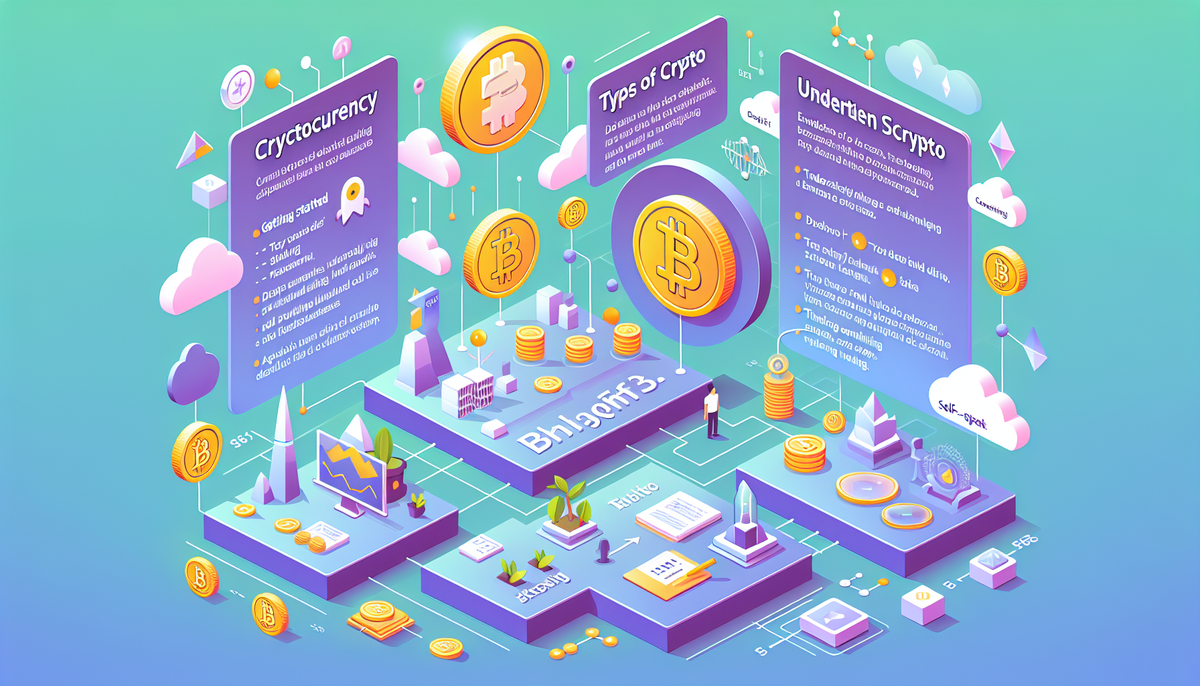Crypto and Web3: What Should You Know?

Crypto and Web3: What Should You Know?
The terms "Crypto" and "Web3" are everywhere, promising a revolutionary shift in how we interact with technology and finance. For many, these concepts remain shrouded in mystery, seeming complex and inaccessible. This article aims to lift that veil. We will break down the crypto basics, explore the exciting world of Web3 finance, and show how understanding this new digital frontier is a crucial step in self-growth and financial empowerment. Whether you're curious about digital currency or the future of the internet, this guide will provide a clear and comprehensive overview.
What is Cryptocurrency?: A Beginner's Guide to Digital Currency
This section will break down the fundamentals of cryptocurrency, explaining what it is, how it works, and introducing the core technology behind it. Understanding these crypto basics is the first step into the larger world of Web3 finance.
The Core Idea: What is Crypto?
At its heart, a cryptocurrency is a digital or virtual token that uses cryptography for security. Unlike traditional currencies issued by governments (like the U.S. Dollar or the Euro), cryptocurrencies are decentralized. This means they are not controlled by any single entity, like a bank or government. The most famous example is Bitcoin, but thousands of different digital currency assets exist today. They enable peer-to-peer transactions across the globe without the need for a traditional intermediary.
Blockchain: The Engine Behind Digital Currency
The magic that makes cryptocurrency possible is a technology called blockchain. Imagine a digital ledger or notebook that is duplicated and distributed across a vast network of computers. When a transaction occurs, it's recorded as a "block" of data. This block is then "chained" onto the end of the previous block, creating a chronological and unchangeable record of all transactions. This distributed and cryptographic nature makes the ledger incredibly secure and transparent, as tampering with one block would require altering all subsequent blocks across the entire network—a virtually impossible feat.
Types of Crypto: Beyond Bitcoin
While Bitcoin was the first, the crypto landscape has exploded with variety. Ethereum is another major player, which introduced the concept of "smart contracts"—self-executing contracts with the terms of the agreement directly written into code. This innovation paved the way for decentralized applications and the broader Web3 ecosystem. Beyond these giants, there are "altcoins" with various functions, from privacy-focused coins to tokens that govern specific platforms or projects. Understanding that not all digital currency is the same is a key part of the crypto basics.
Getting Started with Crypto: Your First Steps into Web3 Finance
A practical guide for those ready to dip their toes into the world of digital currency, covering the essential tools and platforms. Taking these first steps is how you begin to engage with the emerging world of Web3 finance.
Choosing a Crypto Wallet
Before you can own any digital currency, you need a place to store it. This is where a crypto wallet comes in. There are two main types: hot wallets (software-based, connected to the internet, and convenient for frequent trading) and cold wallets (hardware-based, offline, and more secure for long-term storage). For beginners, starting with a reputable software wallet from a major exchange is often the easiest entry point. Your wallet gives you a public address (for receiving funds) and a private key (for accessing your funds, which you must keep secret and safe).
How to Buy and Sell Digital Currency
The most common way to buy and sell crypto is through a centralized cryptocurrency exchange. These platforms, like Coinbase or Binance, function like online brokerages for digital assets. You can sign up, connect a funding source like a bank account or debit card, and easily purchase popular cryptocurrencies like Bitcoin or Ethereum. It's crucial to use a well-established exchange with a strong security track record. Once purchased, you can either keep your crypto on the exchange or move it to your personal wallet for greater control.
Understanding the Risks: Volatility and Security
Entering the world of Web3 finance is exciting, but it comes with significant risks. The value of cryptocurrencies can be extremely volatile, with prices fluctuating dramatically in short periods. It's essential to only invest what you can afford to lose. Furthermore, security is paramount. The decentralized nature of crypto means that if you lose your private keys or fall victim to a scam, there is no central authority to appeal to for help. Always use strong, unique passwords, enable two-factor authentication (2FA), and be wary of unsolicited offers or requests for your private information.
Understanding Web3: The Next Evolution of the Internet
Explore the concept of Web3, the decentralized internet, and how it aims to shift power from big tech companies to individual users. This is where the true potential of crypto and blockchain technology broadens beyond simple digital currency.
From Web1 to Web3: A Quick History
Web1 was the "read-only" internet of the 1990s, with static websites and little interaction. Web2 is the "read-write" internet we use today, dominated by user-generated content on centralized platforms like Facebook, Google, and Twitter. While we create the content, these corporations own the platforms and our data. Web3 is the "read-write-own" internet. It envisions a decentralized web built on blockchain technology, where users have ownership and control over their data, digital assets, and online identity.
Key Components of Web3: dApps, DAOs, and Smart Contracts
Web3 is built on several core components. Smart Contracts, as mentioned earlier, are the foundational building blocks. Decentralized Applications (dApps) are applications that run on a peer-to-peer network (like a blockchain) rather than a single computer. This makes them resistant to censorship and single points of failure. Decentralized Autonomous Organizations (DAOs) are internet-native organizations where decisions are made collectively by members, often through voting with governance tokens. These components work together to create a more transparent, user-centric online world.
How Web3 and Crypto Are Connected
Crypto is the financial engine of Web3. Cryptocurrencies provide the native digital currency needed to interact with dApps and DAOs. They act as the incentive layer that secures the network and rewards participants. For example, you might use a specific digital currency to pay for services on a dApp, vote in a DAO's decision-making process, or purchase a digital item (like an NFT) within the Web3 ecosystem. Essentially, crypto provides the economic framework for the decentralized internet to function.
The Future is Decentralized: Crypto, Web3, and Your Financial Growth
This section delves into how Web3 technologies, particularly Decentralized Finance (DeFi), are creating new opportunities for financial management and self-growth. This is where Web3 finance moves from theory to practical application.
DeFi: Reimagining Financial Services
Decentralized Finance (DeFi) is one of the most significant movements within Web3. It aims to rebuild traditional financial systems—like lending, borrowing, trading, and earning interest—using decentralized technology. Instead of relying on banks and brokerages, DeFi uses smart contracts on blockchains like Ethereum. This allows for a more open, transparent, and accessible financial system where anyone with an internet connection and a crypto wallet can participate, without needing permission from a central authority.
Passive Income in Web3: Staking and Yield Farming
DeFi opens up new avenues for passive income that were previously unavailable to the average person. "Staking" involves locking up your cryptocurrency holdings to help secure a blockchain network, and in return, you earn rewards in the form of more crypto. "Yield farming" is a more complex strategy where users move their assets between different DeFi lending and liquidity protocols to maximize their returns. While these strategies come with risks, they represent a powerful new way to make your assets work for you within the Web3 finance ecosystem.
Web3 and Self-Growth: Taking Control of Your Digital Identity and Assets
Beyond finance, Web3 represents a significant step in personal empowerment and self-growth. By giving you true ownership of your digital assets and data, Web3 changes your relationship with the internet. You are no longer just a user of a platform; you are a stakeholder in the network. This shift encourages financial literacy, long-term thinking, and a proactive approach to managing your digital life. Learning about these systems is an investment in your ability to navigate the next generation of technology and finance.
Conclusion: Your Journey into the New Digital Economy
We've journeyed from the crypto basics to the expansive vision of Web3 finance. The key takeaways are simple: cryptocurrency is secure, digital money powered by blockchain, and Web3 is the next phase of the internet that leverages this technology to create a more user-centric, decentralized world. The combination of these forces, especially in the realm of DeFi, is creating unprecedented opportunities for financial self-growth. The world of digital currency is still young and volatile, but it's a field ripe with potential. We encourage you to continue your learning, proceed with caution, and embrace the powerful journey of taking control of your financial and digital future.



